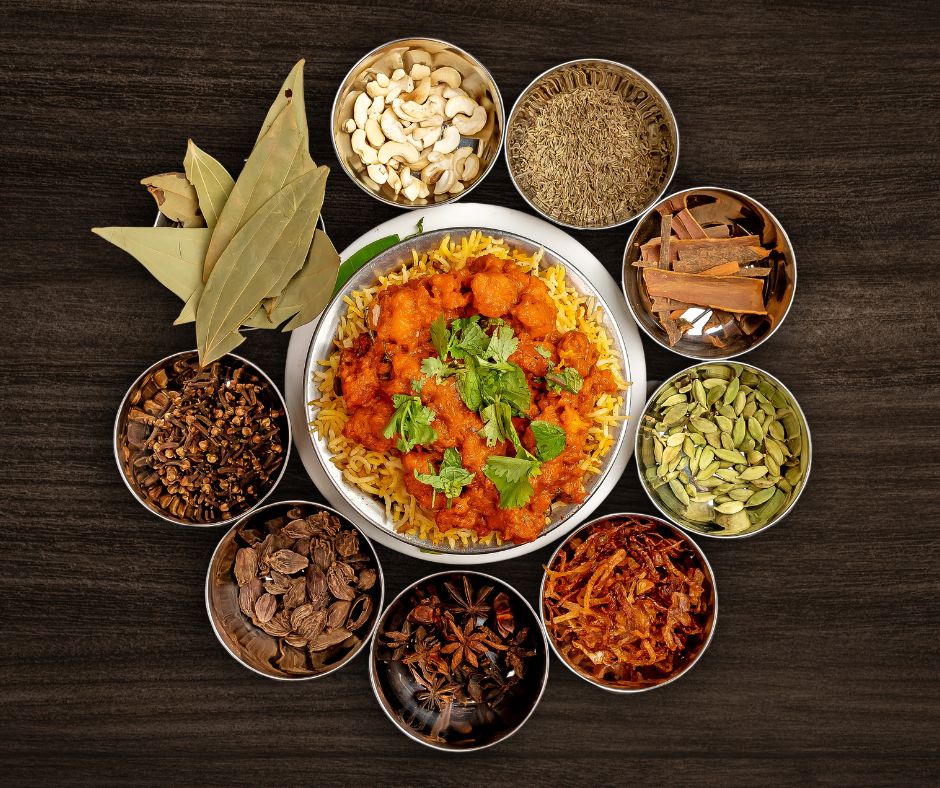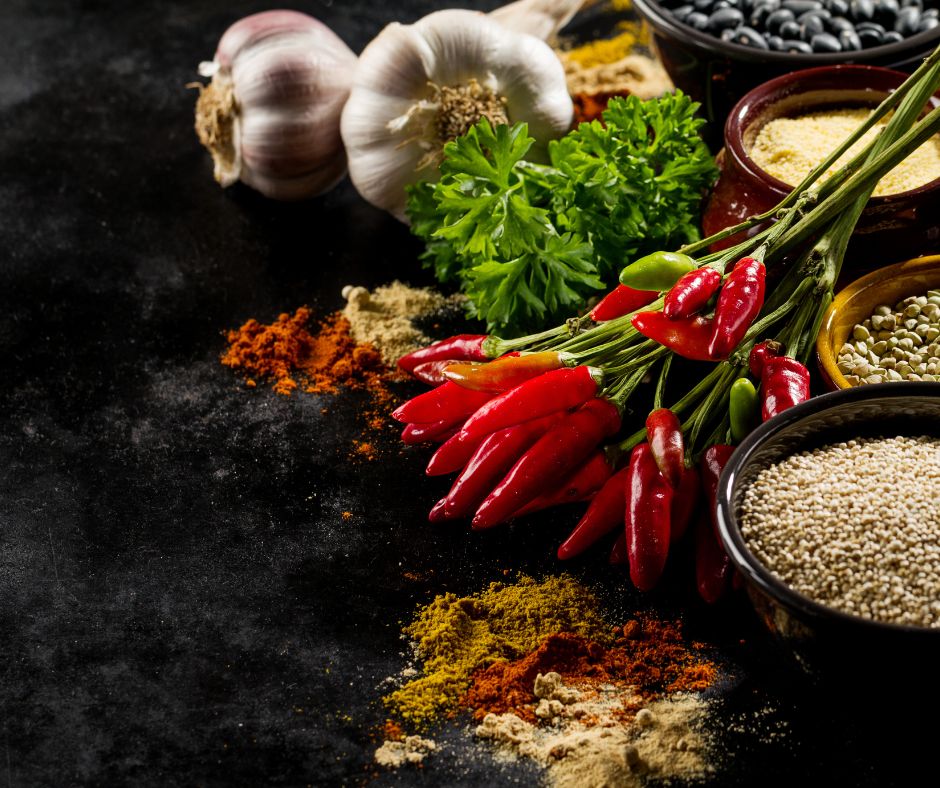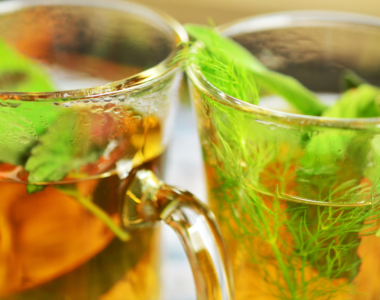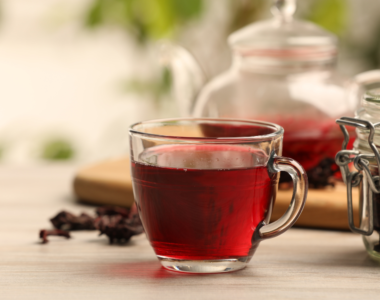
Table of Contents
USING HERBS AND SPICES
Although spices and herbs have been used since antiquity, they now have a new and significant role in the preparation of food today. They not only give our cuisine distinctive flavors but also color and variety. Some herbs and spices can replace or reduce salt and sugar in cuisine when used alone or in blends.
What are spices and herbs?

Many people interchangeably refer to any item of plant origin used mostly for seasoning food when they use the terms. Strictly speaking, spices are made from tropical plants, whereas herbs are derived from aromatic species grown in the temperate zone. Herbs are often utilized in their leaves, although spices might be derived from bark, berries, flower buds, roots, or seeds.
Do herbs and spices add any nutritive value to foods?
Herbs and spices are only used to flavor or color food; they have very little if any, nutritional benefit. While some of the oil-rich seeds, like poppy and sesame, have a significant number of calories, they are generally low in calories, salt, fat, and cholesterol. Moreover, some seasonings, such as celery or parsley flakes, have a sufficient amount of sodium to count. But because they are used in such small amounts, these components are not a problem unless a recipe calls for an exceptionally big amount or unless the diet limitation is extremely rigorous.
Using Herbs and Spices
Today, the most common piece of advice is, “Use herbs and spices for taste instead of salt.” This raises the question, which spice should I use with which foods? The amount? how are they combined? Here are some places to start:
- Start with some of the simpler herbs and spices because they are less expensive. Americans prefer pepper, basil, oregano, and cinnamon in particular.
- Mix a herb with butter, margarine, or cream cheese, let it sit for at least an hour, then try it on a cracker to get a feel for the flavor.
- Despite the fact that each spice and herb have a unique flavor, some can be combined.
- Strong or dominant flavor- Includes Bay leaf, cardamom, ginger, pepper, mustard, rosemary, and sage. Curry is essentially a combination of spices.
- Medium flavors – Use in moderation (1 to 2 teaspoons for 6 servings). includes marjoram, mint, oregano, savory, thyme, turmeric, celery seeds, leaves, and seeds, cumin, dill, fennel, French tarragon, and dill.
- Delicate flavors – includes parsley, chives, burnet, and chervil. May be blended with the majority of other herbs and spices and used in big amounts.
- The sweet flavor includes cinnamon, cloves, allspice, ginger, cardamom, anise, fennel, and mint. When used in sweet recipes, it may be possible to reduce the amount of sugar.
- Think about the form that will be employed. Because the compounds that provide the distinctive flavor are more concentrated in dried herbs, they are more potent than fresh herbs. Because the flavorful agents may blend with the food more easily in powdered spices, they are more potent than crumbled spices. A good reference is: 2 to 3 teaspoons of fresh ingredients are equal to 3/4 to 1 teaspoon of powdered food.
- Utilize whole spices in recipes that call for extended cooking since there is ample opportunity for the flavor to develop and permeate the dish. Nevertheless, prolonged simmering reduces the flavor of herbs, so add them in the final 45 minutes if the recipe specifies this step. Another method is to use a portion of the herb at the start and the rest subsequently.
- Choose savory or pungent spices, herbs, mixes, and veggie seasonings to reduce the amount of salt in your food. Black pepper, garlic powder or granules, cumin, curry powder, dill seeds, basil, ginger, coriander, onion, tarragon, and oregano are all good options.
Is it really worth buying fresh spices? My grocery store spices seem fine.
Fresh spices offer a whole new level of flavor compared to pre-ground options. They have a more vibrant aroma and a more complex taste that can completely transform your dishes. While pre-ground spices have their place, fresh spices add a depth of flavor that can elevate even simple meals.
Fresh spices sound intimidating – are they hard to use?
Not at all! Many fresh spices are easy to incorporate. Garlic cloves just need a quick mince, ginger can be grated, and spices like cumin seeds can be toasted briefly in a pan to release their aroma. Most recipes include easy instructions for using fresh spices.
I’m worried fresh spices will go bad before I can use them all. What can I do?
Fresh spices generally last longer than you might think! Whole spices like peppercorns or coriander seeds can last for months. Chilies, ginger, and garlic can last weeks in the refrigerator. Store them properly in airtight containers away from heat and light to maximize their shelf life.
Fresh spices seem more expensive than pre-ground options. How can I justify the cost?
A little goes a long way with fresh spices. You’ll often use less compared to pre-ground versions, making them more cost-effective in the long run. Plus, the taste difference is remarkable, so you’ll get more satisfaction from your meals.
What are some easy ways to introduce fresh spices to my family’s meals?
Start simple! Add some freshly grated ginger to your stir-fry or sprinkle some chopped fresh parsley on pasta dishes. Fresh herbs like basil or oregano are a great way to add brightness to salads or pizza. Experiment with different spices and find flavors your family enjoys.
My kids are picky eaters. Will fresh spices make them like new foods?
The vibrant flavors of fresh spices can make even familiar dishes more appealing. Let your kids explore the scents of different spices and involve them in the cooking process. Fresh herbs like basil on pizza or chopped chives on scrambled eggs can add a fun twist that might entice picky eaters.
Are there any health benefits to using fresh spices?
Many spices boast health benefits! Garlic, for example, is known for its immune-boosting properties. Turmeric has anti-inflammatory qualities. While these benefits might be subtle, incorporating a variety of fresh spices into your meals can contribute to a healthier lifestyle.
Where can I find fresh spices?
Many grocery stores offer a selection of fresh spices alongside pre-ground options. Ethnic markets often have a wider variety, especially for international cuisine. Consider buying online from reputable retailers for a broader selection.
What tools do I need to use fresh spices?
You don’t need a lot of fancy equipment! A good knife, a cutting board, and a microplane grater are all you really need for most fresh spices. A mortar and pestle can be a fun way to grind spices for extra flavor impact, but a spice grinder works too.
I’m feeling inspired! Do you have any resources for recipes using fresh spices?
There are countless resources available! Many cooking websites and blogs feature recipes that highlight fresh spices. Cookbooks dedicated to specific cuisines, like Thai or Indian food, often rely heavily on fresh spices. With a little searching, you’ll find endless recipe inspiration to explore the exciting world of fresh flavors!



